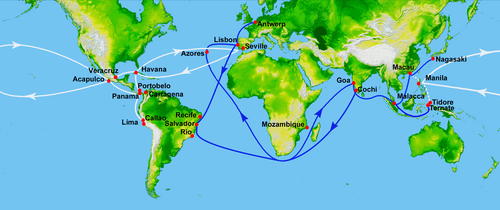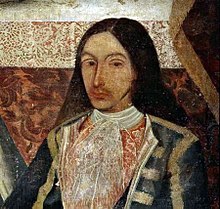User:Goatmanatee/Spanish treasure fleet
Changes that occurred to the fleet system, such as the Bourbon Reforms, the economic concessions of the Treaty of Utrecht, the use of registered ships, and the introduction of monopolistic trading companies, could be mentioned. The process of bringing goods overland by mule train could also be slightly expanded on.
The article is neutrally written.

The Spanish treasure fleet, or West Indies Fleet Spanish: Flota de Indias (also called silver fleet or plate fleet; from the Spanish: plata meaning "silver"), was a convoy system of sea routes organized by the Spanish Empire from 1566 to 1790, which linked Spain with its territories in the Americas across the Atlantic. The convoys were general purpose cargo fleets used for transporting a wide variety of items, including agricultural goods, lumber, various metal resources such as silver and gold, gems, pearls, spices, sugar, tobacco, silk, and other exotic goods from the overseas territories of the Spanish Empire to the Spanish mainland. Spanish goods such as oil, wine, textiles, books and tools were transported in the opposite direction.[1][2]
The West Indies fleet was the first permanent transatlantic trade route in history. Similarly, the Manila galleons were the first permanent trade route across the Pacific. The Spanish West and East Indies fleets must be counted as among the most successful naval operations in history[3][4] and from a commercial point of view made possible many key components of today's global economic system.[5]
Decline, Reform and Abolition[edit]
The economic importance of exports later declined with the drop of production of the American precious metal mines, such as Potosí.[6] However, the growth in trade was strong in the early years. Numbering just 17 ships in 1550, the fleets expanded to more than 50 much larger vessels by the end of the century. By the second half of the 17th century, that number had dwindled to less than half of its peak.[7] As economic conditions gradually recovered from the last decades of the 17th century, fleet operations slowly expanded again, once again becoming prominent during the reign of the Bourbons in the 18th century.[8]
The Spanish trade of goods was sometimes threatened by its colonial rivals, who tried to seize islands as bases along the Spanish Main and in the Spanish West Indies. However, the Atlantic trade was largely unharmed. The English acquired small islands like St Kitts in 1624; expelled in 1629, they returned in 1639 and seized Jamaica in 1655. French pirates established themselves in Saint-Domingue in 1625, were expelled, only to return later, and the Dutch occupied Curaçao in 1634. Other losses to foreign powers came later. In 1713 as part of the Treaty of Utrecht after the War of the Spanish Succession, the Spanish crown was forced to make concessions which included trading privileges for England that violated the previous Spanish monopoly on legal trade to its colonial holdings.[9] In 1739 during the War of Jenkin's Ear,[9] the British Admirals Francis Hosier and later Edward Vernon blockaded Portobello in an attempt to prevent the return sailing of the treasure fleet, but in 1741 Vernon's campaign against Cartagena de Indias ended in defeat, with heavy losses of men and ships. Temporary British seizures of Havana and Manila (1762–4), during the Seven Years' War, were dealt with by using a larger number of smaller fleets visiting a greater variety of ports.
The end of the War of the Spanish Succession in 1713 marked the beginning of the rule of the Bourbon dynasty, which brought with it the Bourbon Reforms. These reforms, designed to halt Spain's decline and increase tax revenue, brought about a series of changes to the fleet system throughout the 18th century.[9] Philip V began the reforms by sending investigators to report on conditions in Spanish America, who brought back evidence of fraud.[9] He and following Bourbon kings, notably including Charles III, would make a concerted effort to centralize the administration of Spanish America and more efficiently tax profits from overseas trade.[9] One of these reforms was the granting of trading monopolies for certain regions to trading companies ran by peninsulares, such as the Guipuzcoan Company.[9] Another involved the increased use of registered ships, or navíos de registro, traveling solo outside of the fleet system to transport goods.[10] These reforms gradually decreased reliance on the escorted convoys of the fleet system.[9] In the 1780s, Spain opened its colonies to freer trade.[11] In 1790, the Casa de Contratación was abolished, bringing to an end the great general purpose fleets. Thereafter small groups of naval frigates were assigned specifically to transferring goods or bullion as required.[12]
The Fleets[edit]

Every year, two fleets left Spain loaded with European goods in demand in Spanish America, which were guarded by military vessels. Valuable cargo from the Americas, most significantly silver from Mexico and Peru, were sent back to Spain. Fleets of fifty or more ships sailed from Spain, one bound for the Mexican port of Veracruz and the other for Panama and Cartagena.[13] From the Spanish ports of Seville or Cádiz, the two fleets bound for the Americas sailed together down the coast of Africa, and stopped at the Spanish territory of the Canary Islands for provisions before the voyage across the Atlantic. Once the two fleets reached the Caribbean, the fleets separated. The New Spain fleet sailed to Veracruz in Mexico to load not only silver and the valuable red dye cochineal, but also porcelain and silk shipped from China on the Manila galleons. The Asian goods were brought overland from Acapulco to Veracruz by mule train.[14] The Tierra Firme fleet, or galeones, sailed to Cartagena to load South American products, especially silver from Potosí. Some ships went to Portobello on the Caribbean coast of Panama to load Peruvian silver that had been shipped from the Pacific coast port of Callao. The silver had then been transported across the isthmus of Panama by mule. Other ships went to the Caribbean island of Margarita, off the coast of Venezuela, to collect pearls which had been harvested from offshore oyster beds. After loading was complete, both fleets sailed for Havana, Cuba, to rendezvous for the journey back to Spain.[15]
The overland journey by mule train, as well as supplies provided by local farmers to prepare the fleets for long ocean voyages, invigorated the economy of colonial Spanish America. Preparation and the transport of goods required porters, innkeepers, and foodstuffs to help facilitate travel.[14] However, in Mexico in 1635, there was an increase of the sales tax levied to finance the fleet, the Armada de Barlovento.[16]
Between 1703 and 1705 Spanish corsair Amaro Pargo began participation in the West Indies Fleet. In this period he was the owner and captain of the frigate El Ave María y Las Ánimas, a ship with which he sailed from the port of Santa Cruz de Tenerife to that of Havana. He reinvented the benefits of the Canarian-American trade in his estates, mainly destined to the cultivation of the vine of malvasía and vidueño, whose products (mainly the one of vidueño) were sent to America.[17]
Links to the article[edit]
Spanish colonization of the Americas
Global silver trade from the 16th to 19th centuries
Timeline of international trade
- ^ Marx, Robert: Treasure lost at sea: diving to the world's great shipwrecks. Firefly Books, 2004, page 66. ISBN 1-55297-872-9
- ^ Marx, Robert: The treasure fleets of the Spanish Main. World Pub. Co., 1968
- ^ Walton, page 189
- ^ Konstam, Angus and Cordingly, Daviv (2002).The History of Pirates. The Lyons Press, p. 68. ISBN 1-58574-516-2
- ^ Walton, page 191
- ^ Walton, page 136
- ^ Walton, page 138
- ^ Walton, page 177
- ^ a b c d e f g Burkholder, Mark A., 1943-. Colonial Latin America. Johnson, Lyman L., (Tenth edition ed.). New York. ISBN 978-0-19-064240-2. OCLC 1015274908.
{{cite book}}:|edition=has extra text (help)CS1 maint: extra punctuation (link) CS1 maint: multiple names: authors list (link) CS1 maint: numeric names: authors list (link) - ^ Moutoukias, Zacarias (1988). "Power, Corruption, and Commerce: The Making of the Local Administrative Structure in Seventeenth-Century Buenos Aires". The Hispanic American Historical Review. 68 (4): 771–801. doi:10.2307/2515681. ISSN 0018-2168.
- ^ Buckle, Thomas: History of civilization in England. Parker, Son, and Bourn, 1861, v. 2, pp. 93–94
- ^ Walton, page 180
- ^ Gibson, Charles. Spain in America. New York: Harper & Row, 1966, p. 102.
- ^ a b Seijas, Tatiana (2016-01-02). "Inns, mules, and hardtack for the voyage: the local economy of the Manila Galleon in Mexico". Colonial Latin American Review. 25 (1): 56–76. doi:10.1080/10609164.2016.1180787. ISSN 1060-9164.
- ^ "1733 Spanish Galleon Trail – Plate Fleets". info.flheritage.com. Retrieved 2015-05-13.
- ^ John Jay TePaske, "Alcabalas" in Encyclopedia of Latin American History and Culture vol. 1, p. 44. New York: Charles Scribner’s Sons 1996.
- ^ De Paz Sánchez, Manuel; García Pulido, Daniel (2015). El corsario de Dios. Documentos sobre Amaro Rodríguez Felipe (1678-1747). Documentos para la Historia de Canarias. Francisco Javier Macías Martín (ed.). Canarias: Archivo Histórico Provincial de Santa Cruz de Tenerife. ISBN 978-84-7947-637-3. Retrieved 8 June 2016.
